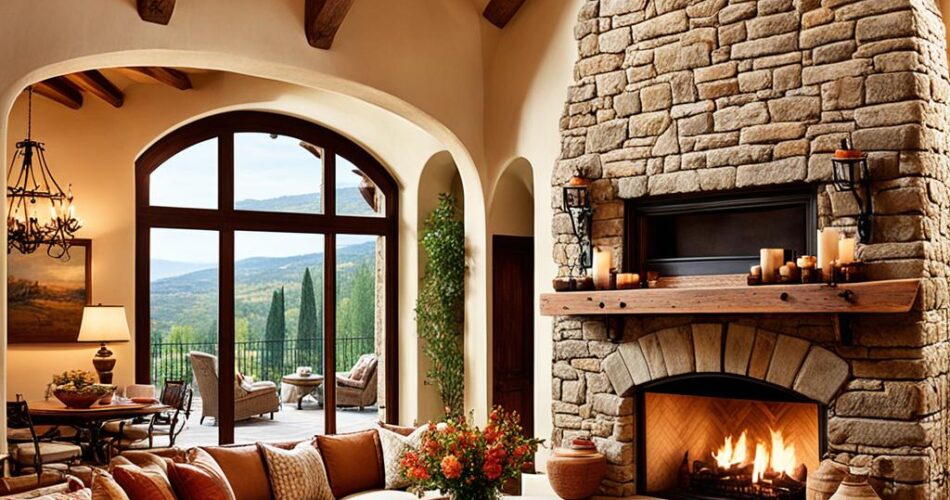Tuscan style homes have become very popular in the United States. They bring a piece of the Italian countryside to American homes. These homes mix rustic elegance with old world charm. This makes them feel both grand and cozy.
Tuscan homes are inspired by Mediterranean architecture. They use materials like terracotta, stone, and warm woods. The colors are like the sunny Tuscan landscape, with earthy tones on both inside and outside.
Italian villa design often has high ceilings with exposed wooden beams. This adds warmth and makes rooms look bigger. Rooms can seem up to 14% larger because of this.
Tuscan interiors are all about comfort and timeless beauty. You’ll find handcrafted furniture, woven textiles, and wrought iron accents. These elements bring the beauty of la dolce vita into every room.
The Origins and History of Tuscan Architecture
Tuscan architecture has a long history, starting in 900 B.C. The Etruscan people built simple homes using local materials. This set the stage for italian countryside architecture. Over time, it was shaped by Roman and Renaissance art, creating the tuscan architecture we see today.
Influence of Etruscan, Roman, and Renaissance Art
The Etruscans introduced the Tuscan Order, a classic architectural style. Roman art added grandeur, and the Italian Renaissance brought elegance. Together, these elements made Tuscan homes what they are today.
Evolution from Rural Necessities to Timeless Design
Initially, Tuscan architecture was practical for rural life. It has since become a popular design style. Traditional homes use limestone, sandstone, terracotta, and marble. These materials match the natural surroundings, creating estates that feel like they belong in the Italian countryside.

Cultural Significance in Italian Heritage
Tuscan architecture is very important in Italy. It shows the region’s artistic past and bond with the earth. This style has become popular in places like Florida and California. Modern Tuscan homes keep their classic look while using new technology, keeping this style alive.
Key Characteristics of Tuscan Style Homes
Tuscan style homes bring the feel of the Italian countryside to your living space. They mix rustic beauty with timeless design. This creates a cozy and welcoming feel.
One key feature of Tuscan homes is their terracotta roofs. These clay tiles are strong and look beautiful. The walls often have stucco finishes, giving them a textured look that looks old and Mediterranean.

Arched windows and doorways are common in Tuscan homes. They let in lots of natural light. These curved shapes make the home look softer and more flowing.
Wrought iron accents, like balcony railings and light fixtures, add special touches. They look great against the rough stone of the home.
Courtyards are a big part of Tuscan homes. They’re perfect for relaxing or having guests over. These areas have stone paths, greenery, and places to sit, making the inside and outside feel connected.
| Feature | Description | Benefits |
|---|---|---|
| Terracotta Roofs | Clay tiles in warm, earthy tones | Durability, heat resistance, aesthetic appeal |
| Stucco Walls | Textured exterior finish | Weather resistance, low maintenance, rustic charm |
| Arched Windows | Curved openings with decorative frames | Enhanced natural light, architectural interest |
| Wrought Iron Accents | Decorative metalwork on balconies and fixtures | Elegant detailing, contrast with stone elements |
| Courtyards | Open-air living spaces within the home | Outdoor entertaining, seamless indoor-outdoor flow |
Natural Materials: The Foundation of Tuscan Design
Tuscan style homes use the beauty of natural materials. These elements make the design timeless and earthy.
Terracotta Tiles: Roofing and Flooring
Terracotta tiles are key to Tuscan architecture. They add a warm, earthy look to roofs and floors. Over time, these tiles get a beautiful patina that makes them even more appealing.
Stone and Stucco: Creating Textured Exteriors
Exterior walls of Tuscan homes are full of texture. Stone and stucco make them look and feel special. This design connects the home to the Tuscan landscape, making it look like part of the natural world.
Wooden Beams: Rustic Charm and Structural Elements
Exposed wooden beams are both useful and decorative in Tuscan design. They help hold up high ceilings and add beauty. The wood’s natural look and feel make interiors warm and cozy.
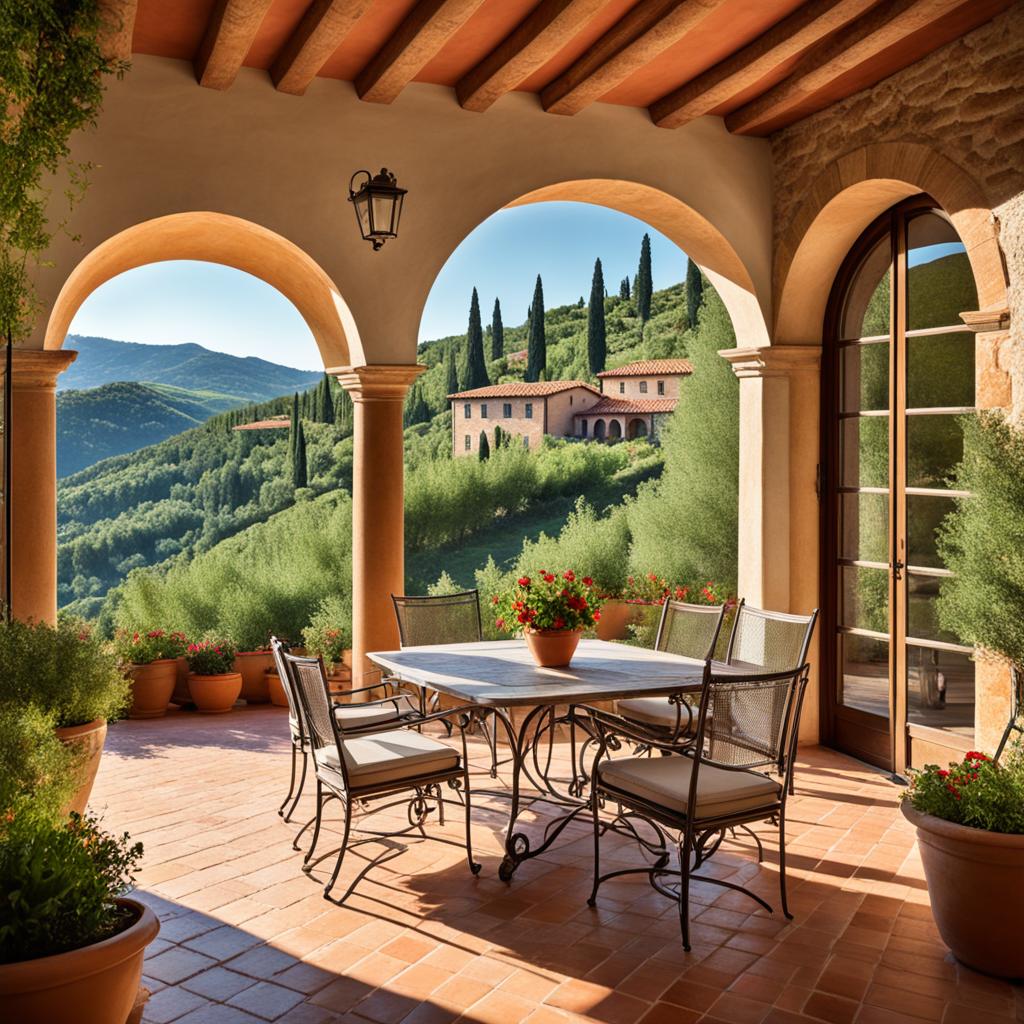
| Material | Primary Use | Characteristics |
|---|---|---|
| Terracotta Tiles | Roofing, Flooring | Warm tones, Durable, Ages beautifully |
| Stone | Exterior walls | Textured, Natural look, Weather-resistant |
| Stucco | Exterior finish | Smooth or textured, Versatile, Low maintenance |
| Wooden Beams | Ceiling support, Decor | Rustic charm, Structural strength, Adds warmth |
Color Palettes Inspired by the Tuscan Landscape
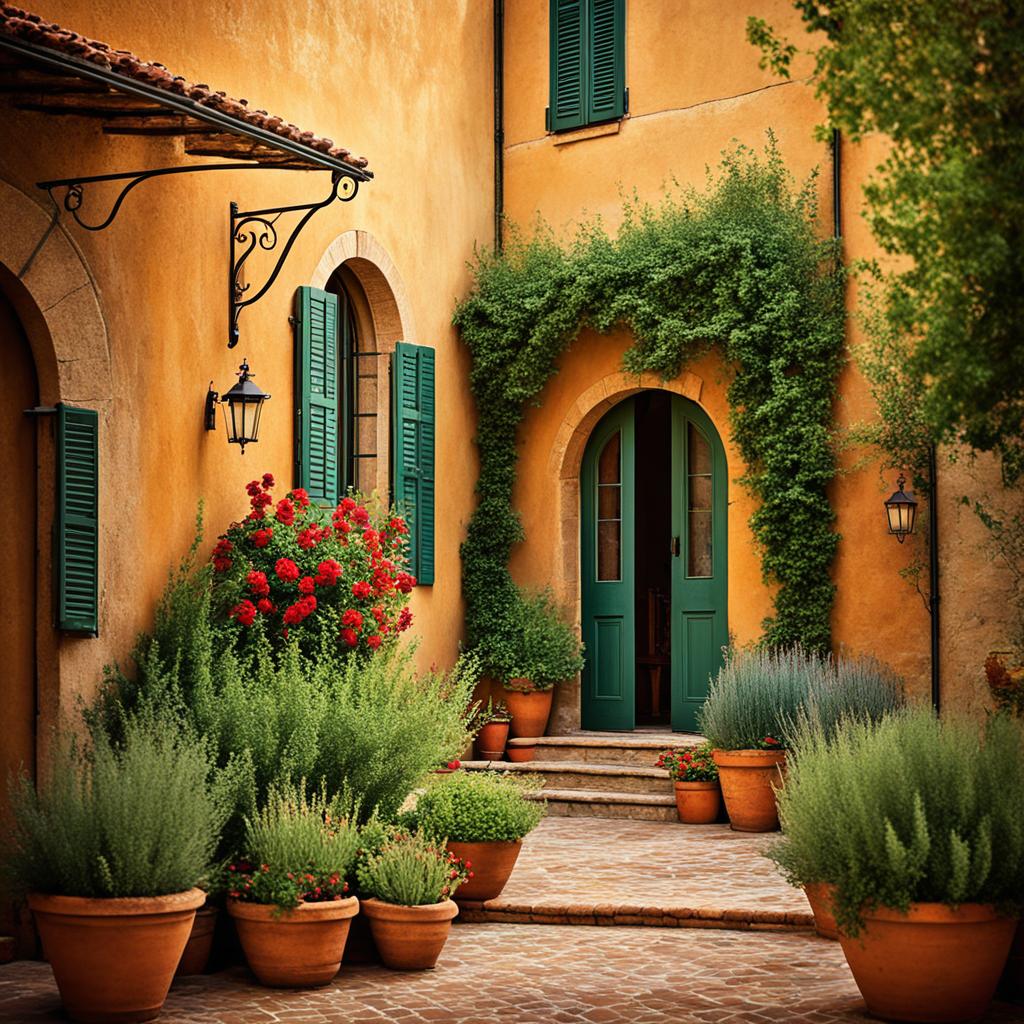
Tuscan style homes take their cue from Italy’s sunny landscapes. They use warm colors to make spaces cozy and welcoming. Earthy tones are key, echoing the Tuscan countryside’s natural beauty.
The classic Tuscan palette features cream, warm red, sage green, golden ochre, and rust orange. These colors embody Mediterranean home decor and bring the outdoors in. Dark apricot, various browns, and warm neutrals add depth and elegance.
For a modern twist on Tuscan style, think about adding cooler colors like serene blue or calming purple. These colors offer a fresh contrast to the warm tones but keep the Mediterranean vibe.
| Color Family | Popular Shades | Mood |
|---|---|---|
| Reds | Terracotta, Rust, Wine | Warm, Inviting |
| Yellows | Golden Ochre, Sunflower, Pale Yellow | Sunny, Cheerful |
| Greens | Olive, Sage, Forest | Natural, Earthy |
| Neutrals | Cream, Beige, Taupe | Elegant, Timeless |
When picking paint colors for your Tuscan-inspired home, look at Benjamin Moore Firenze, Sherwin-Williams Garden Sage, or Behr’s Bicycle Yellow. These colors capture the Tuscan landscape’s spirit and add warmth to any room.
Architectural Features of Tuscan Style Homes
Tuscan style homes have unique features that bring the Italian countryside to your home. They mix beauty with practicality. This makes them both stunning and useful.
Arched Windows and Doorways
Arched windows and doorways are key to Tuscan design. They add elegance inside and out. These curves make moving from one room to another smooth and beautiful.
Arched entryways also welcome guests with a hint of classic charm.
Courtyards and Outdoor Living Spaces
Courtyards are a big part of Tuscan homes. They connect indoor and outdoor living. These areas often have:
- Stone pathways lined with cypress trees
- Fountain areas for a soothing ambiance
- Outdoor dining spaces for al fresco meals
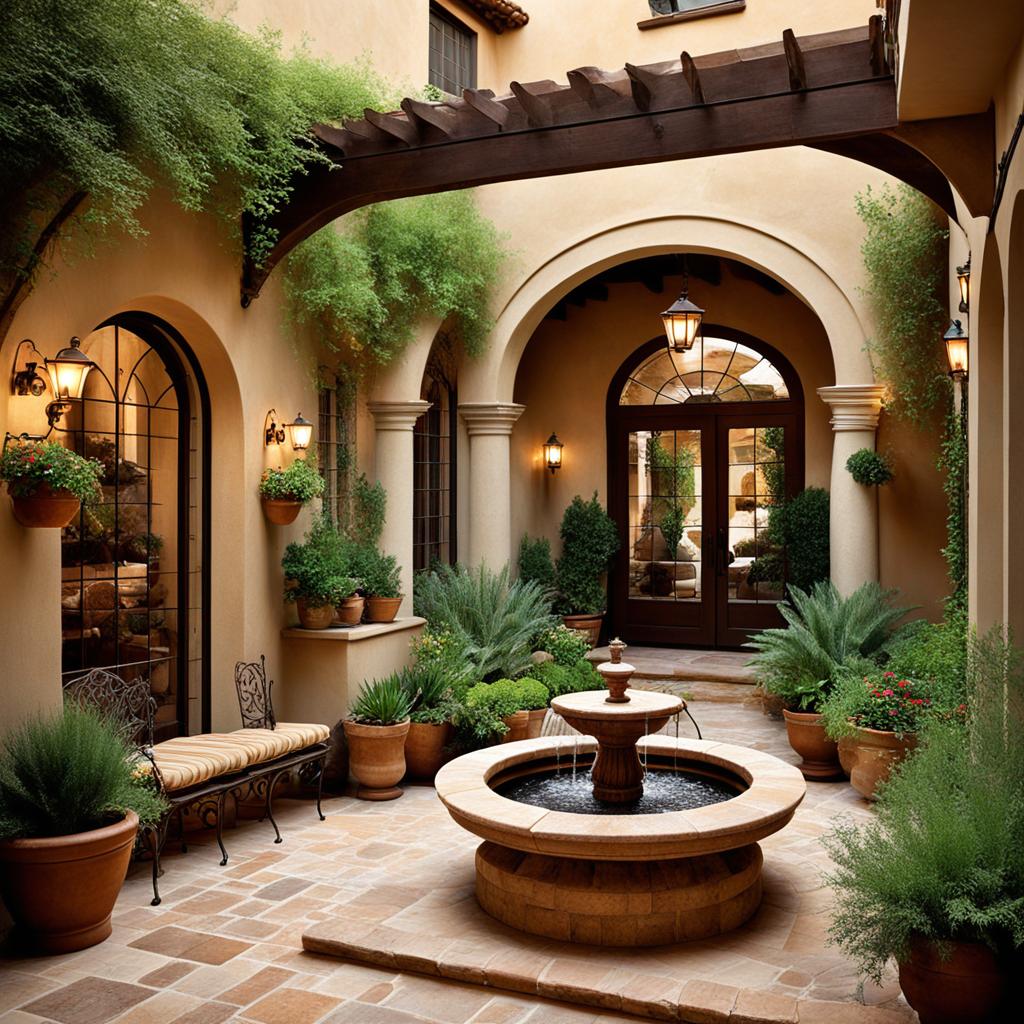
Wrought Iron Accents and Details
Wrought iron adds character to Tuscan homes. It comes in many forms:
- Decorative balcony railings
- Ornate light fixtures
- Intricate gates and fences
These iron pieces contrast well with stone and stucco. They add a medieval touch. Tuscan homes use these features to create a timeless, welcoming feel. They bring the beauty of the Italian countryside to your home.
Interior Design Elements in Tuscan Homes
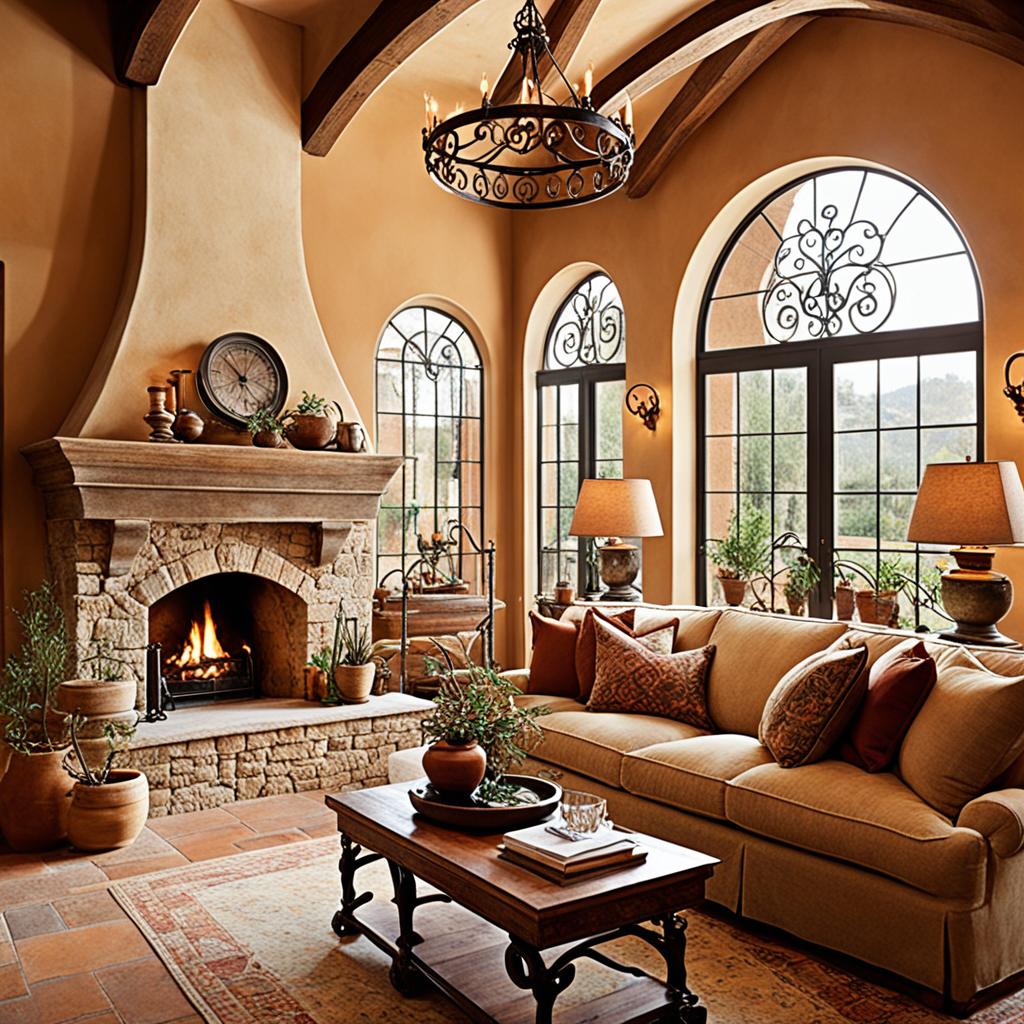
Tuscan interior design brings the warmth of the Italian countryside indoors. It combines rustic charm with elegant simplicity. This creates spaces that feel cozy and timeless. Warm earth tones like terracotta, ocher, and cream set a welcoming tone.
In rustic home interiors inspired by Tuscan design, natural materials are key. Rough-hewn wooden beams and stone or terracotta tiles add texture and character. They make you feel like you’re in an Italian villa.
Furniture in Tuscan homes is sturdy with simple lines. Often made from local wood, these pieces look better with age. Big, comfy sofas and large dining tables encourage people to gather, showing the Italian love for socializing.
- Wrought iron accents in lighting fixtures and kitchen appliances
- Open shelving in kitchens for a casual, functional feel
- Tapestries and fabric wallpapers for added warmth and visual interest
- Generous use of natural fabrics like linen and cotton
Mediterranean home design elements are big in Tuscan interiors. Hand-painted ceramics, intricate tile work, and carved wooden accents add visual interest. These details celebrate the region’s rich craftsmanship heritage.
Modern Tuscan interiors mix traditional with contemporary. Lighter colors and minimalist accents give a fresh look to the classic style. This shows Tuscan design can stay current while keeping its timeless charm.
Blending Tuscan Style with Modern Living
Tuscan-inspired homes are changing to fit today’s families. A recent update of a 4,000-square-foot house shows how Tuscan style can mix with modern life. It’s for a young couple with a growing family, combining rustic charm with modern comforts.
Contemporary Interpretations of Tuscan Design
Modern Mediterranean homes are moving away from their old ’90s look. They now have warm whites and soft neutrals for bright spaces. The update included making the sunken living room higher and removing old features for a modern look.
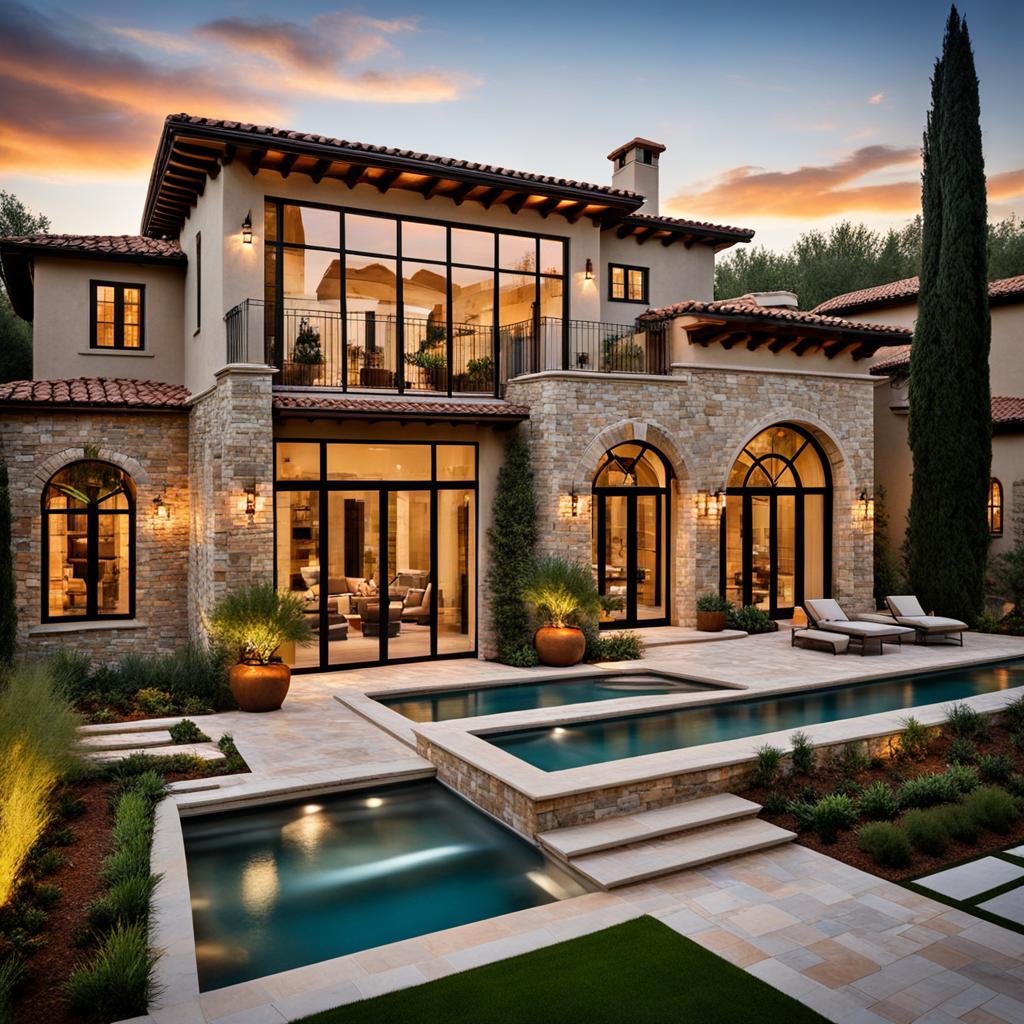
Balancing Rustic Charm with Modern Amenities
The updated home has both old and new touches. It has warm woods and hand-knotted rugs for texture, and a Calacatta marble fireplace for luxury. The main bathroom has a spa-like feel with Portola’s green Nitty Gritty wash.
In the kids’ rooms, fun colors like Portola’s pink Casa California add personality. Yet, they still look stylish.
Sustainable Practices in Tuscan-Inspired Homes
Sustainable architecture is important in Tuscan home updates. This project used energy-efficient systems and green materials. The outdoor areas have simple landscaping and modern furniture for a smooth indoor-outdoor connection.
By mixing Tuscan style with modern design and green practices, this home offers a new take on Mediterranean living for today.
Landscaping for Tuscan Style Homes
Tuscan landscaping brings the charm of Mediterranean gardens to your doorstep. Imagine a scene with cypress trees and olive groves, creating a peaceful escape. These plants, along with herbs like lavender, rosemary, and thyme, are key to authentic Tuscan gardens.
Warm earth tones are the main colors in Tuscan yards. Gabriel Frank, a landscape designer, recommends using gold granite and decomposed granite for paths. Bright flowers in red, orange, and hot pink add color, like the Italian countryside.
Water-wise gardening is important in Tuscan landscaping. Mediterranean plants need less water than traditional lawns, making them good for the planet. Many use sustainable practices like collecting rainwater and using greywater. These methods save water and match the Tuscan way of living with nature.
To add to the Tuscan feel, think about a rustic pergola with grapevines or bougainvillea. A small fountain or reflecting pool can be a peaceful spot, showing the Italian love for outdoor living. With these touches, your Tuscan-style home will feel like a piece of Italy in your backyard.
